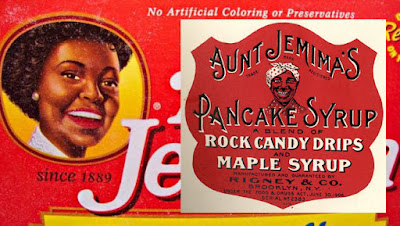When art infuriates, it shows us how much art has engaged.
 |
| Aunt Jemima now and then. Her image has changed as American attitudes toward blacks have changed. |
One of my regrets is that I never bought a Lenin statue when the Soviet Union collapsed. If they weren’t destroyed on site, they were sold as scrap metal.
Iconoclasm—the tearing down of art and symbols—happens with every great social change. During our own Revolution, we pulled down the statue of King George in Manhattan, melting it for lead shot.
That tells us how important art really is. “Watching the videoed scene of the mob toppling the bronze Sir Edward over the quayside last week, I felt a kind of thrill at the beating heart of human beings responding viscerally to a piece of art,” wrote Matthew Parrislast week.
 |
|
Empty pedestal of Edward Colston’s monument in Bristol, courtesy of Caitlin Hobbs. |
“Just as it is good when art lifts, inspires, ennobles and pleases us, it’s good too when art infuriates, hurts or inflames. Good in both cases because art has engaged.”
I can’t entirely agree with Parris’ enthusiasm. History has shown how indiscriminate the mob can be. The iconoclasm of the Protestant revolution destroyed more great religious art than it left; the great Ghent Altarpiece only survived because citizens defended it. Iconoclasm is traumatic and divisive. It inflames wounds, rather than healing them.
 |
|
Memorial to Robert Gould Shaw and the Massachusetts 54th Regiment, 1897, by Augustus Saint-Gaudens, courtesy Rhododendrites. |
But it does point out just how important art is to advanced society. The symbols we’re discussing today—caricatures of Uncle Ben, Aunt Jemima, statues of Robert E. Lee—all started out at the nib of an artist’s pen. Their power to infuriate is tied to their former power to motivate.
I have no problem with rolling the statue of a former slaver into Bristol Harbor, but I’m often shocked by the cultural illiteracy of the mob. Among the monuments defaced this month was Boston’s Memorial to Robert Gould Shaw and the Massachusetts 54th Regiment. Luckily, it’s shrouded in plywood for restoration, but it’s not the first time it’s been vandalized: it happened in 2012, 2015, and 2017.
The memorial is a masterpiece by Augustus Saint-Gaudens, and it features both Shaw and his soldiers. Shaw himself was a staunch abolitionist, as woke as anyone in his time. Attacking the memorial confirms our worst fears about rioters, that they are nothing more than ignorant, dangerous thugs.
 |
|
Robert the Bruce’s statue, defaced in Stirling, courtesy STV. |
There’s a slightly different problem with spray-painting “Racist King” on a statue of Robert the Bruce at the site of the Battle of Bannockburn.The concept of race, as we understood it in the 19th century and as we understand it today, meant nothing in 14th century Scotland.
It’s in this small story from Red Hook, NY that I see the most danger. Slavery was abolished in New York starting in 1799. There is no way this woman, based on an image from 1899 and painted in 1996, was meant to be a slave. Nor does she even look black.
 |
|
Mural in Red Hook, NY, that’s stirring cries of racism, courtesy John W. Barry/Poughkeepsie Journal. |
But she’s clearly not white. If protesters have their way, she won’t be on that wall much longer, either. Therein lies the greatest danger of the current round of iconoclasm. In their zeal, protesters risk erasing people of color from our shared history.
Meanwhile, slavery is at historic high levels right now. Some 21-46 million people are currently enslaved worldwide. We’re largely silent on the subject.
“If people put the same energy into tackling modern slavery, I’d be more impressed,” said my pal Kenneth Barker. He recommends Anti-Slavery International. How about the next time you are moved to comment on race and racism, you put a hundred dollars in their kitty instead? I just did.
